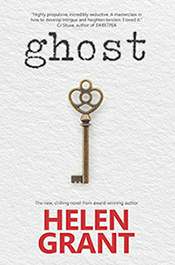


I just spent two days in Paris with my friend the Professor, visiting the catacombs and the sewers as part of the research for my next novels. If you'd like to see a short video of my visit to the catacombs, you can see it on my YouTube channel, here: http://www.youtube.com/user/helengrantsays
I decided to go around the catacombs because I was going to Paris anyway to tour the sewers, and thought this would be an interesting additional visit. My children begged to be allowed to come too, but on the whole I am glad they didn't. I didn't find the ossuary, with its (literally) millions of bones, particularly frightening - although I wouldn't fancy being down there all alone - but it was very affecting. The sheer quantity of Death is overwhelming. I read that six million Parisians are buried there.
The Paris catacombs are very deep underground. In Brussels, the sewers are usually the deepest underground tunnels, running underneath and alongside the Metro. In Paris, the sewers are at a relatively shallow depth, with the Metro below and the catacombs far below that, approximately 20 metres down. The tunnels and chambers which now comprise the catacombs were mostly the result of mining for gypsum and limestone. Around the end of the 18th Century, many of the cemeteries in Paris had to be emptied on health grounds, as they were full to saturation point. The bones were stacked in the catacombs, in neat piles often incorporating patterns using skulls and leg bones. There are stone plaques explaining which stacks of bones came from which cemeteries.
To reach the catacombs, you have to descend a circular stone staircase. There are 130 steps; it takes a while to get to the bottom. You then follow a series of tunnels which lead you to two chambers containing elaborate architectural carvings. There is also a circular staircase (visible but not accessible) leading to an underlit well. Shortly after that you reach an antechamber containing the entrance to the ossuary. Over the door is carved the splendidly morbid legend: Arretez! C'est ici l'empire de la mort. (Stop! This is the Empire of Death.)
Pass through this entrance and you find yourself in the first of a series of rooms piled high with bones. The bones on view are mostly femurs, end on, and skulls; I suppose the smaller bones are stacked somewhere behind these, out of view.
I have seen skeletons, and indeed mummies, many times before in museums, but there is something uniquely and gloomily impressive about the bones in the Paris catacombs. The sheer quantity of them somehow shocked me. This was entirely illogical considering that we all know that millions have gone before us and are now mouldering quietly in the earth. Still, there is a difference between knowing that and actually seeing it. We are all aware of death, and yet in a year we might hear of the deaths of one or two people we know. Considering how many people must die every day, I don't even see hearses particularly often. All of this seems to give Death a comfortable sense of distance. It is a shock, therefore, to walk into the catacombs and be confronted with the sheer scale of our mortality. And these were just the bones of the inhabitants of one city, for a period of a few hundred years! Every one of those skulls had a story of his or her own; every one of those leg bones was once helping to carry its owner about. I am sorry if this sounds unnecessarily morbid, but the fact of the matter is, I went to the catacombs expecting a slightly gruesome thrill, and instead found myself saddened and moved by it.
I think the Professor and I spent longer than the expected 45 minutes underground, deciphering the melancholy inscriptions in French and Latin. We didn't touch any of the bones; people evidently had, as some of the skulls are smooth and shiny, but I didn't like to. I was glad to have visited the catacombs, but all the same it was a relief when we had climbed the stairs back up to the street level and found ourselves outside in the spring sunshine.








What a wonderful article, Helen. I would love to visit the catacombs one day. From what you describe, it sounds as if the bones were buried there with great care. I think that is both moving and beautiful...
ReplyDeleteThank you, Jenna. It must have been a huge task to collect, sort and arrange the bones the way they did. Whether it is right for us to go and stare at them is another thing; I am still not sure about that. But none of the visitors were anything other than respectful - including the large group of students who went in very noisily just ahead of us.
ReplyDelete